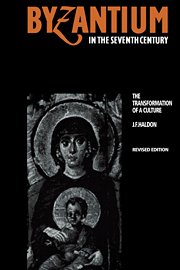Book contents
- Frontmatter
- Contents
- List of plates
- List of maps
- Preface and acknowledgements
- Preface to the revised edition
- List of abbreviations
- The sources
- Introduction
- 1 The background: state and society before Heraclius
- 2 The East Roman world c. 610–717: the politics of survival
- 3 Social relations and the economy: the cities and the land
- 4 Social relations and the economy: rural society
- 5 The state and its apparatus: fiscal administration
- 6 The state and its apparatus: military administration
- 7 Society, state and law
- 8 The imperial church and the politics of authority
- 9 Religion and belief
- 10 Forms of social and cultural organisation: infrastructures and hierarchies
- 11 Forms of representation: language, literature and the icon
- Conclusion: The transformation of a culture
- Addendum: Further observations on the question of the late ancient city
- Bibliography
- Index
1 - The background: state and society before Heraclius
Published online by Cambridge University Press: 13 November 2009
- Frontmatter
- Contents
- List of plates
- List of maps
- Preface and acknowledgements
- Preface to the revised edition
- List of abbreviations
- The sources
- Introduction
- 1 The background: state and society before Heraclius
- 2 The East Roman world c. 610–717: the politics of survival
- 3 Social relations and the economy: the cities and the land
- 4 Social relations and the economy: rural society
- 5 The state and its apparatus: fiscal administration
- 6 The state and its apparatus: military administration
- 7 Society, state and law
- 8 The imperial church and the politics of authority
- 9 Religion and belief
- 10 Forms of social and cultural organisation: infrastructures and hierarchies
- 11 Forms of representation: language, literature and the icon
- Conclusion: The transformation of a culture
- Addendum: Further observations on the question of the late ancient city
- Bibliography
- Index
Summary
It is all too easy to forget that every human society, whatever its achievements and the ways in which it impresses itself upon its natural context, is closely bound to its geographical and climatic conditions of existence in ways which may at first seem insignificant, or so obvious as to need no further consideration. Not only methods of agriculture and the production of social wealth, but modes of dress and the technology of clothing, for example, are subject to these conditions, although it is not always possible to determine exactly how the relationship operates. This is no less the case for the late Roman state and for late Roman society and culture, which occupied and dominated the east Mediterranean basin, the Balkans and much of the north African littoral up to the middle of the seventh century. The many local cultures and their histories which were incorporated into that state and were subject to its administrative and political machinery consequently varied very greatly in their appearance one from another, inasmuch as the geographical and climatic features of the zones in which they were located varied. It is useful to emphasise this perhaps obvious point at the outset.
- Type
- Chapter
- Information
- Byzantium in the Seventh CenturyThe Transformation of a Culture, pp. 9 - 40Publisher: Cambridge University PressPrint publication year: 1990

